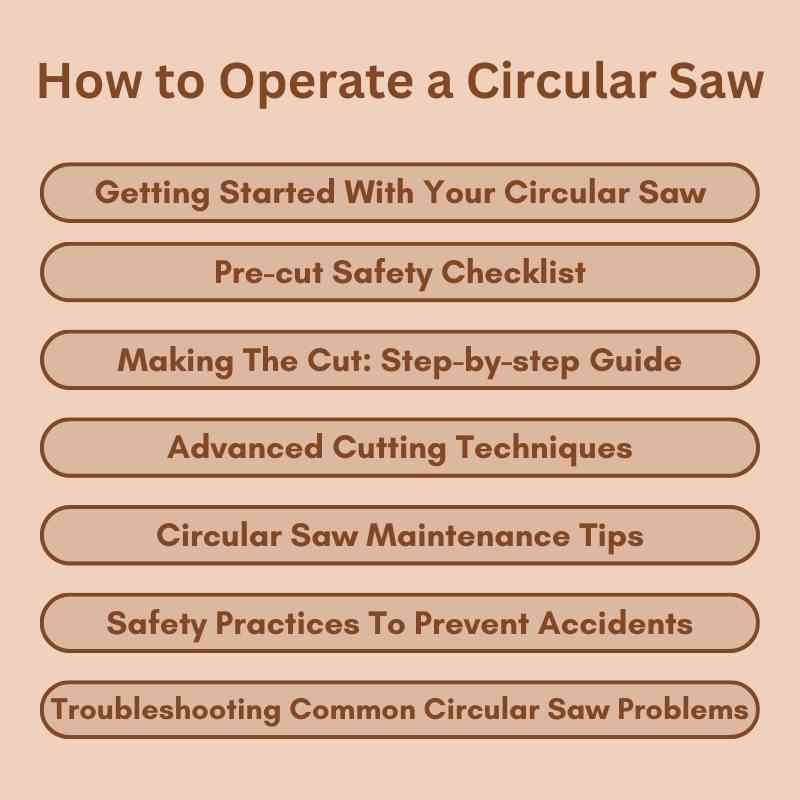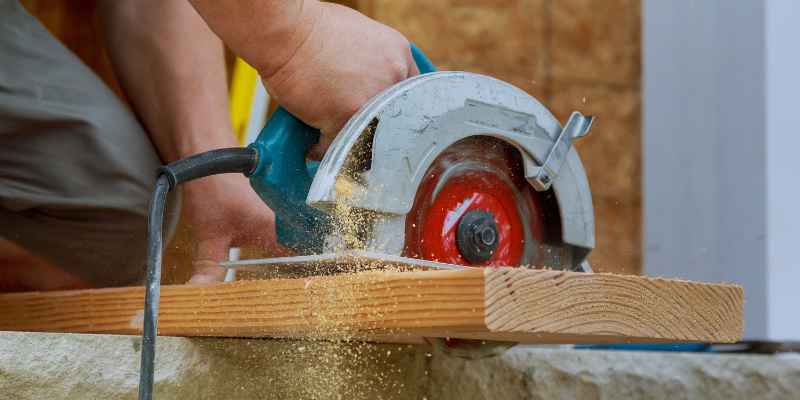To operate a circular saw, start by measuring and marking your cut line. Next, securely clamp the material and plug in the saw.
A circular saw is an essential tool for any woodworking project. It provides precision and efficiency, making it a favorite among both beginners and seasoned professionals. Understanding how to operate it safely and effectively can greatly enhance your woodworking skills.
Before starting, familiarize yourself with the saw’s components, including the blade, depth adjustment, and safety features. Proper preparation is key; always wear safety gear and ensure your workspace is clear. Mastering the circular saw will not only improve your cutting accuracy but also boost your confidence in handling various materials. Let’s dive into the steps for operating this powerful tool.
Getting Started With Your Circular Saw
Choosing the right circular saw is crucial for your projects. Consider the size and power of the saw. A 7-1/4 inch saw is a popular choice. It can handle most cutting tasks easily.
Next, understand the different blade types available. Carbide-tipped blades last longer and cut efficiently. High-speed steel blades are suitable for softer materials. Choose a blade based on the material you will cut.
| Blade Type | Best For |
|---|---|
| Carbide-Tipped | Hardwoods and composites |
| High-Speed Steel | Softwoods |
| Diamond Blade | Tile and masonry |

Setting Up For Your First Cut
Start by measuring your material accurately. Use a tape measure for precise lengths. Mark your cut line with a pencil or chalk. Ensure the line is straight for a clean cut.
Next, secure the material to prevent movement. Use clamps to hold it firmly in place. This step is crucial for safety and accuracy. If clamps are not available, place the material on a stable surface.
Pre-cut Safety Checklist
Before using a circular saw, wearing Personal Protective Equipment (PPE) is essential. Always wear safety goggles to protect your eyes from flying debris. Hearing protection is also important, as saws can be loud. Wearing dust masks can help avoid inhaling harmful particles.
Inspecting the saw is crucial for safe operation. Check the blade for any damage or dullness. Ensure the guard is functioning properly. Verify that all screws and bolts are tight. Always make sure the power cord is not frayed or damaged.
Performing these checks can prevent accidents and ensure a smooth cutting experience. Always prioritize safety before starting any project.
Making The Cut: Step-by-step Guide
Positioning the saw correctly is crucial for a clean cut. First, place the circular saw on top of the material. Ensure the blade hangs off the edge. The plate must be flat against the surface. This setup promotes stability and precision.
Before cutting, mark the cut line clearly. Use a speed square to guide the saw. Clamp the material firmly to avoid movement during cutting. Safety gear like goggles and gloves is essential for protection.
While guiding the saw, push it slowly and steadily. Keep both hands on the saw for better control. Avoid forcing the tool; let it do the work. This method ensures a clean and accurate cut.
Advanced Cutting Techniques
Cutting angles and bevels require careful adjustment. Set the bevel angle on the saw to achieve desired cuts. Use a speed square for accurate angles. Place it against the material for guidance. This helps ensure straight, clean cuts.
Using a saw guide is essential for precision. A guide keeps the saw on track. Clamp the guide securely to the work surface. Align the saw blade with the cut line for best results. This method reduces mistakes and improves overall accuracy.
Practice will enhance your skills. Experiment with different angles to gain confidence. With time, cutting angles and using a saw guide will become second nature.

Circular Saw Maintenance Tips
Proper maintenance is crucial for optimal circular saw performance. Regularly check the blade for sharpness and cleanliness. Ensure the saw’s components are free of debris, and lubricate moving parts to enhance longevity and efficiency.
Cleaning Your Saw
Regularly cleaning your circular saw is essential for optimal performance. Use a soft brush to remove dust and debris. Pay special attention to the ventilation slots to prevent overheating. A damp cloth can help remove any sticky residues. Ensure the blade is free of pitch and sap to maintain cutting efficiency.
Blade Sharpening And Replacement
Sharpening your saw blade extends its life. Use a sharpening file or professional service for best results. Replace the blade when it shows significant wear or damage. A dull blade can cause kickback and unsafe cutting conditions. Always follow the manufacturer’s instructions for blade installation.
Safety Practices To Prevent Accidents
To prevent kickback, always keep a firm grip on the saw. Stand to the side of the cut line. This position protects you from possible kickback incidents. Use the right blade for your material to ensure smooth cuts.
Proper handling is essential for safety. Always unplug or remove the battery when changing blades. Store the saw in a dry place, away from children. Keep the blade covered to avoid accidents during storage.
Regularly inspect the saw for any damages. Ensure the cord is intact and the blade is sharp. A dull blade can cause kickback and lead to injuries. Follow these practices to ensure a safe and efficient cutting experience.
Troubleshooting Common Circular Saw Problems
Saw Won’t Start: Check the power source first. Ensure the cord is plugged in. Look for damage on the cord or switch. If the saw has a battery, make sure it is charged. A faulty battery may need replacement. Always inspect the trigger for any issues.
Irregular Cuts or Binding: Ensure the blade is sharp and properly installed. A dull blade can cause binding. Check if the material is clamped securely to prevent movement. Use a straightedge as a guide for better accuracy. Adjust the cutting speed for thicker materials.
Frequently Asked Questions
What Are The Steps In Operating The Circular Saw?
To operate a circular saw, follow these steps: 1. Measure and mark the cut line clearly. 2. Secure the material firmly to a workstation. 3. Attach the correct blade to the saw. 4. Set the desired bevel angle. 5. Plug in or charge the saw before use.
What Is The Correct Way To Use A Circular Saw?
To use a circular saw correctly, measure and mark your cut line. Secure the material with clamps. Adjust the blade depth and bevel angle as needed. Position the saw with the blade over the edge. Power on and push the saw steadily along the cut line.
Always wear safety gear.
How Do You Use A Saw Step By Step?
To use a saw, follow these steps: 1. Measure and mark your cut line. 2. Secure the material on a stable surface. 3. Select and attach the right blade. 4. Adjust the saw’s depth and angle. 5. Power on and cut along the marked line.
How Is A Circular Saw Operated?
To operate a circular saw, start by measuring and marking your cut line. Secure the material to a stable surface. Attach the correct blade and set the bevel angle if needed. Plug in or power the saw. Finally, guide the saw steadily along the cut line.
Conclusion
Operating a circular saw can greatly enhance your woodworking projects. By following the steps and safety tips outlined in this guide, you can achieve clean, precise cuts with confidence. Remember, practice makes perfect. Always prioritize safety and take your time.
Happy cutting, and enjoy your woodworking journey!

